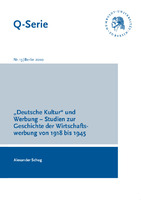"Deutsche Kultur" und Werbung – Studien zur Geschichte der Wirtschaftswerbung von 1918 bis 1945
Abstract
This dissertation offers a history of modern commercial advertising during the first half of the twentieth century and demonstrates that despite cultural barriers, advertising colonized the everyday world of Germans and began to encroach upon “German culture”. The work shows that the construct of “German culture” was not only defined by bourgeois high culture, but rather increasingly by factors from consumer culture. The imagery of advertising shaped national icons, created modified “surfaces” (for example, through illuminated ad media) and perceptions of space. Likewise, the logic of market differentiation and marketing began to determine social interactions as well as political communication (Hitler branding). This development did not progress without conflict: Debates surrounding both advertising as well as the direct confrontation between cultural critics and advertisers make clear that there was a massive collision between two mentalities. This allowed a conflict to emerge between traditional, guild thinking, high cultural representations and a putatively authentic aesthetics of content, on the one hand, and on the other hand, a “world of appearances” and aesthetic of the exterior form. One question in particular played a central role in this debate, namely: the extent to which capitalism, the market economy, consumption and the aesthetics of the modern Lebenswelt with its specific (commercial) texture were in accord with ideas of “Germanness.” Die Arbeit präsentiert die Geschichte der modernen Wirtschaftswerbung in der ersten Hälfte des 20. Jahrhunderts und zeigt, dass Werbung trotz kultureller Barrieren die Alltagswelten der Deutschen kolonialisierte und Einfluss auf die „deutsche Kultur“ nahm. Die Arbeit zeigt, dass das Konstrukt der „deutschen Kultur“ nicht ausschließlich durch die bürgerliche Hochkultur definiert wurde, sondern zunehmend auch durch Einflüsse der Konsumkultur bestimmt war. Die Bilderwelten der Werbung prägten nationale Ikonen, schufen (bspw. durch Leuchtwerbung) modifizierte "Oberflächen" und Raumwahrnehmungen, ebenso wie die Logik der Marktdifferenzierung und des Marketing soziale Interaktionen als auch die politische Kommunikation (Hitler als Marke) zu bestimmen begann. Diese Entwicklung verlief nicht konfliktfrei. Sowohl die Debatten über Werbung als auch die direkte Konfrontation zwischen Kulturkritikern und Werbern verdeutlichen den massiven Zusammenprall zweier Mentalitäten, die den Konflikt von traditionellem zünftigem Denken, hochkultureller Repräsentation sowie einer vermeintlich authentischen Ästhetik des Inhalts auf der einen Seite und einer "Welt des Scheins" und einer Ästhetik der äußeren Form auf der anderen Seite hervortreten ließ. In dieser Debatte spielte eine Frage eine zentrale Rolle: inwieweit Kapitalismus, Marktwirtschaft, Konsum und die Ästhetik der modernen Lebenswelt mit ihrer spezifischen (werblichen) Oberflächenstruktur mit Vorstellungen "des Deutschen" zu vereinbaren waren.
Keywords
ästhetik; popkultur; 20th century; bauhaus; consumer history; pop culture; deutsche kultur; consumerism; hochkultur; wirtschaftswerbung; werbung; werkbund; konsumgeschichte; commercial advertising; advertising; german culture; konsumismus; aesthetics; high culture; 20. jahrhundert; Alexander Schug; NationalsozialismusDOI
10.26530/OAPEN_382633OCN
808385256Publisher
Humboldt-Universität zu BerlinPublication date and place
2010Series
Q-Serie, 13Classification
History
History: specific events and topics
Social and cultural history
Industrialisation and industrial history
Cultural studies
Media studies: TV and society
Media studies: advertising and society
Advertising


 Download
Download Web Shop
Web Shop